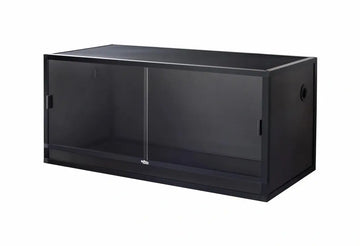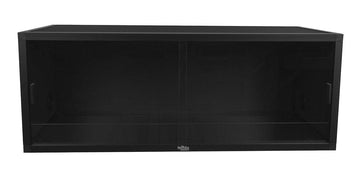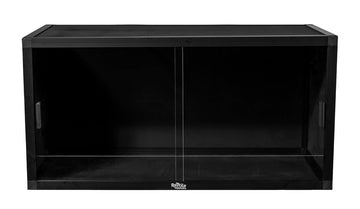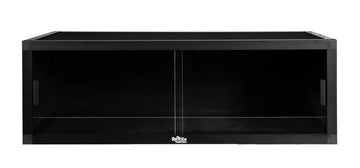The fire skink (Mochlus fernandi) is a 12-15” long, diurnal lizard native to west Africa. They can be found in tropical forest and woodland habitats, where they dwell on the forest floor.
Fire skinks have a small head, large black eyes, an elongated body, stubby limbs, and a tapered tail. They are best known for their unique coloring, which is a mosaic of metallic red, yellow, bronze, black, and white scales.
Fire skinks are generally intermediate-level pet reptiles, with captive-bred individuals making better pets than wild-caught. With good care, they can have up to a 20-year lifespan.
Minimum terrarium size for fire skinks
The minimum terrarium size for a fire skink is 36”L x 18”W x 18”H. Of course, these are quite active lizards, so larger is always better — if you provide, they will absolutely use it!
Housing multiple fire skinks in the same terrarium is not recommended, and is likely to result in fighting and injuries if attempted.
Do fire skinks need UVB?
Technically fire skinks can survive without UVB, but they are healthier when it is provided. UVB lighting helps provide a clear day/night cycle, provides all of the vitamin D that your pet needs, strengthens the immune system, facilitates better digestion, and other benefits.
The best UVB bulbs for fire skinks are:
- Zoo Med Reptisun T5 HO 5.0
- Arcadia Desert 6%
For best results, house the UVB bulbs in a reflective fixture, preferably Arcadia or Vivarium Electronics. Position the lamp on the same side of the terrarium as the heat lamp. If the lamp is positioned over mesh, the basking area should be placed 9-11” below for best results.
UVB is blocked by glass and plastic, so placing the terrarium in front of a window doesn’t count as “free UVB” — in fact it can make your terrarium too hot due to the greenhouse effect. And don’t forget to replace your bulb every 12 months!
Lights and heating should be on for only 12 hours/day, and turned off at night.
Best temperature for fire skinks
Fire skinks should have a basking area temperature around 95°F. The cool side temperature should stay between 75-85°F, and heat sources should be turned off at night. Temperatures may safely drop down as low as 65°F.
Provide heat for your skink with two halogen heat bulbs placed close together. Halogen heat bulbs are better at imitating sunlight, and considered to be a superior form of reptile heating by experts. Do not use ceramic heat emitters (CHEs), red bulbs, or blue bulbs, as these are not as effective.
For best results, use a large flat stone (ex: flagstone, paver stone, slate tile) as the basking surface. Measure temperatures with a digital probe thermometer with the probe placed on the basking surface.
Best humidity levels for fire skinks
Fire skinks generally need average humidity levels between 60-70%. Measure the average humidity in your skink’s enclosure with a digital probe hygrometer, with the probe placed in the middle of the terrarium.
You can increase and maintain humidity by mixing water into the substrate, misting with a spray bottle, and providing a humid hideout lined with moistened sphagnum moss.
Best substrate for fire skinks
“Loose” substrates that mimic a reptile’s natural environment present a low impaction risk, cushion the animal’s joints, and offer a place where they can exercise natural burrowing behaviors. These substrates also help maintain correct humidity levels.
We recommend the following substrates for fire skinks:
Layering clean, chemical-free leaf litter on top of the substrate can also help with humidity.
Substrate should be around 6” deep and completely replaced every 3-4 months. Remove poop and urates daily, along with contaminated substrate.
How to decorate a fire skink terrarium
An empty terrarium leads to a bored skink. Keep your pet entertained and engaged with its environment with the strategic use of décor items that encourage it to exercise natural behaviors.
At bare minimum, you will need at least two hides/”caves” for the skink to use. However, it’s best to include other items, such as:
- hollow logs
- climbing rocks
- ledges
- additional hides
- live or artificial plants
- misc. ornaments
What to feed to a fire skink
Fire skinks are insectivores, which means that they need both plant- and animal-based foods in their diet. Juveniles should be fed daily, and adults should be fed 2-3x/week depending on body condition. At each feeding, offer as many insects as your skink is capable of eating in roughly 5 minutes.
Insects for fire skinks: dubia roaches, discoid roaches, crickets, grasshoppers, mealworms, superworms, earthworms, hornworms, silkworms, snails, black soldier fly larvae
The key to balanced nutrition is variety, so make sure your skink gets as many different (but still appropriate) foods as possible! In addition to the main diet, fruit, waxworms, pinky mice, and quail eggs are treats that add extra nutrients to your skink’s routine.
Supplements
You will also need calcium and vitamin supplements to help keep your skink healthy. We recommend Repashy Calcium Plus LoD, lightly dusted on all of your skink’s feeder insects and organ or muscle meats. It’s okay to occasionally skip a dusting.
Water
Of course, don’t forget a large, shallow water bowl for your skink to drink from and soak in! Change the water daily and scrub the bowl with a reptile-safe disinfectant weekly, or whenever it becomes soiled.
How to handle your fire skink
Reptiles generally don’t appreciate petting and handling in the same way that dogs and cats do. Fire skinks are one of the types of reptiles that usually prefer to be left alone rather than handled regularly, although there are exceptions. One of the best ways to interact with your pet fire skink is to hand-feed it with a pair of feeding tweezers.
*This care sheet contains only very basic information. Although it’s a good introduction, please further your research with high-quality sources. The more you know, the better you will be able to care for your pet!
"File:Riopa fernandi.jpg" by User:Haplochromis is licensed under CC BY-SA 3.0











